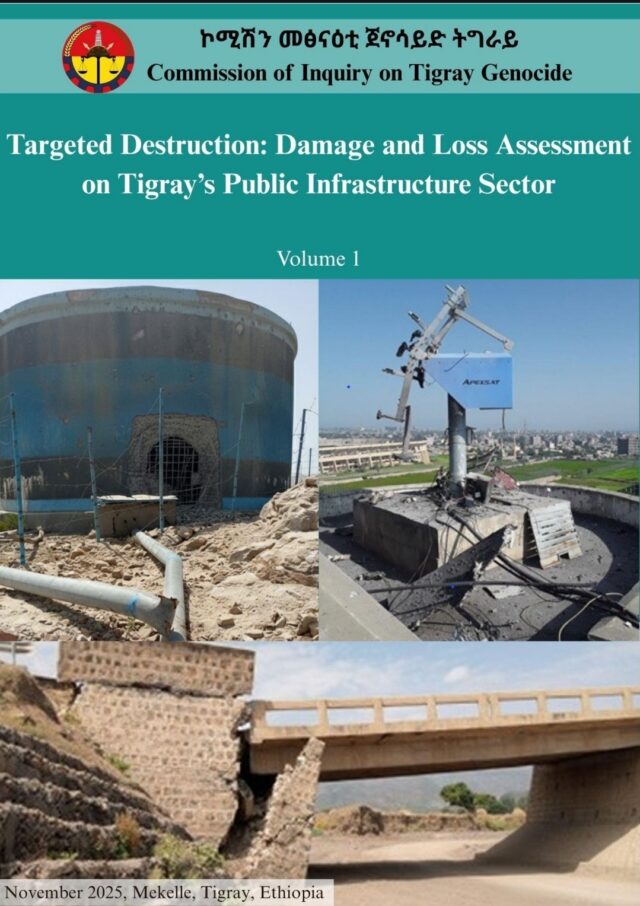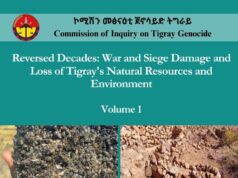Mekelle, November 13, 2025 (Tigray Mass Media Agency)- A new report by Commission of Inquiry on Tigray Genocide (CITG) exposes USD 5 billion worth of destruction across Tigray’s infrastructure sectors, citing deliberate targeting by Ethiopian National Defense Forces (ENDF), Eritrean Defense Forces (EDF), and allied regional forces during the two-year war on Tigray.
The Commission of Inquiry on Tigray Genocide (CITG) has released a report revealing that the war on Tigray caused over USD 5 billion in damages and economic losses across major public infrastructure sectors.
The report, titled “Targeted Destruction: Damage and Loss Assessment on Tigray’s Public Infrastructure Sector, Volume I,” describes the devastation as systematic and intentional, reversing decades of development gains in Tigray.
According to the report, which is available on the commission’s official website https://citghub.org/targeted-destruction-damage-and-loss-assessment-on-tigrays-public-infrastructure-sector/, the Damage and Loss Assessment (DaLA) covered five key sectors — Water, Sanitation & Hygiene (WASH); Transport; Municipal Services; Energy; and Media, Telecom & ICT — and found that the Ethiopian National Defense Forces (ENDF), Eritrean Defense Forces (EDF), and allied regional forces were responsible for the majority of the destruction.
Before the outbreak of war in 2020, CITG notes that Tigray had made remarkable progress in infrastructure expansion, with water coverage reaching 58% and rapid growth in the road and energy sectors. The war, however, “reversed decades of development,” leaving millions without access to essential services.
The CITG report states that data collection was carried out under a total blockade, using the World Bank–UN ECLAC Damage and Loss Assessment (DaLA) framework. The process drew information from 10 regional offices, 4 federal institutions, 84 municipal offices, 43 water utilities, and 4 media organizations. The study covered six administrative zones of Tigray, excluding the still-inaccessible Western Tigray.
According to CITG, WASH sustained the highest level of damage, totaling USD 1.1 billion in physical destruction and USD 770 million in economic losses. Over 70% of the Tigray’s water systems were damaged or looted, cutting off access for 3.6 million residents.
The CITG report estimates USD 610.7 million in infrastructure damage and USD 858.4 million in related economic losses. Destroyed bridges, blocked roads, and damaged vehicles paralyzed transportation and trade routes across Tigray.
Municipal operations, including sanitation and waste management, suffered USD 187.4 million in damage and USD 597.1 million in losses. CITG notes that the collapse of municipal revenues further crippled urban administration and service delivery.
The Energy sector faced USD 68 million in direct damage and USD 482 million in losses, according to CITG. The destruction of power substations, transmission lines, and transformers plunged much of Tigray into prolonged blackouts.
CITG confirms that communication networks were “systematically dismantled,” incurring USD 63.6 million in physical damage and USD 262.6 million in economic losses. The blackout also resulted in the death of 82 employees in the media and ICT sectors.
In total, CITG calculates USD 2.03 billion in direct physical damage and USD 2.97 billion in economic losses. However, the commission emphasizes that the true impact “goes far beyond numbers,” citing the humanitarian crisis caused by collapsed water, energy, and communication systems. “The combined and systematic destruction of these five interdependent sectors effectively collapsed the foundational pillars of modern life in Tigray,” CITG stated in the report.
In its conclusion, CITG urges that Tigray’s recovery process must not only rebuild physical structures but also ensure justice and reparations. The data collected through the assessment will inform a Relief, Rehabilitation, and Reconstruction Plan (RRRP) for Tigray and support accountability mechanisms for war-related crimes. “This assessment is more than a record of loss,” CITG concludes. “is the foundational evidence for a threefold imperative: Recovery, Accountability, and Justice.”
For full access to the report and its findings, visit the Commission of Inquiry on Tigray Genocide (CITG) at https://citghub.org/targeted-destruction-damage-and-loss-assessment-on-tigrays-public-infrastructure-sector/








